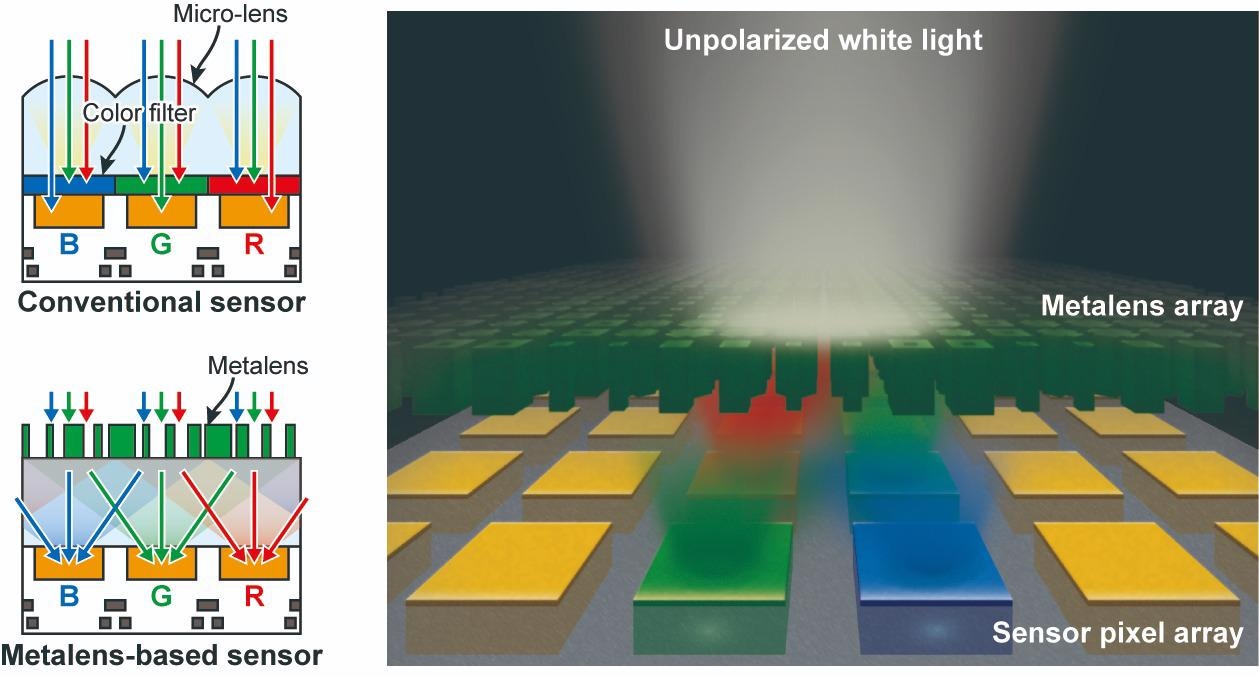Newly developed pixel-scale metasurface lenses — flat surfaces that modify light using nanostructures — have been demonstrated to help create imaging sensors that are about three times more sensitive than those currently in use. The new sensor architecture may allow digital cameras to image faster or in low-light circumstances.
 Researchers have developed a metalens that acts as both a color splitter and a lens. It can be directly integrated on sensor pixels to create a filter-free sensor with increased sensitivity. Image Credit: Masashi Miyata, NTT Device Technology Labs.
Researchers have developed a metalens that acts as both a color splitter and a lens. It can be directly integrated on sensor pixels to create a filter-free sensor with increased sensitivity. Image Credit: Masashi Miyata, NTT Device Technology Labs.
Traditional imaging sensors such as the ones used in smart phones, wearable devices and autonomous vehicles have a limited sensitivity because they rely on color filters placed over each pixel. Our new metalenses are made from a highly-engineered surface that can collect light while simultaneously separating primary colors without any color filters, opening a pathway to dramatically improve sensitivity.
Masashi Miyata, Research Team Leader, NTT Device Technology Labs, Japan
Miyata and colleagues report in Optica — Optica Publishing Group’s journal for high-impact research — that filter-free color sensors developed using the new metalenses considerably improved signal levels without sacrificing spatial resolution or color image quality. Furthermore, as the new metalenses are developed through a CMOS-compatible process, they could be easily combined with existing sensors to make filter-free imaging devices.
We envision our metalenses playing an important role in the development of filter-free color image sensors that exceed current sensitivity limits. These new sensors could one day let people more easily capture night views with smartphones or enable new cameras that accurately capture high-speed objects, which will be useful in security and autonomous driving.
Masashi Miyata, Research Team Leader, NTT Device Technology Labs, Japan
Eradicating Filters
Traditional sensors work based on obtaining color information using color filters that absorb a part of the light. A red filter, for instance, allows only red wavelengths to pass through and absorbs all other wavelengths. That is, only approximately 30% of the light is detected.
To improve sensitivity, the NTT researchers created a metalens array that obtains color information without optical loss using a technique called color sorting. This is accomplished by splitting the light into red, green and blue wavelengths and focusing each color on different pixels. The pixel-scale metalens array was developed by etching nanoposts into a layer of silicon nitride 1250-nm thick.
Other pixel-scale color splitters have been demonstrated in the lab, but they haven’t proven viable for consumer devices because they were either inefficient, impacted by polarization or sensitive to light coming in at an oblique angle.
The new metalenses, on the other hand, are built on a dispersion-rich metasurface substrate that renders them polarization-insensitive and eliminates spectral crosstalk across all color pixels. The metalenses are so effective at focusing light, and thus, oblique light has little effect on their color sorting performance.
Validating Sensor Performance
An optical microscope was employed to simulate the path of light through a metalens array before it reaches a sensor. This experiment revealed that, when compared to a filter-based sensor, the metalens-based sensor produces color images with 2.83-fold higher signal levels while maintaining color quality.
The metalens-based sensor architecture was shown to exhibit less picture degradation due to sensor noise, which is the more common limiting factor in dark-scene or ultra-fast imaging, according to optical simulation tests. The researchers want to develop and test an interconnected device by simply attaching a metalens array onto an image sensor after successfully demonstrating the new sensor concept.
We hope our work will further boost the development of practical optical devices and systems based on metasurfaces. With their ability to flatten and shrink optical components while drastically enhancing performance, we believe that optical metasurfaces can be applied not only to image sensors but also to various optoelectronics devices such as those used in displays, projectors and augmented or virtual reality devices.
Masashi Miyata, Research team leader, NTT Device Technology Labs, Japan
Journal Reference:
Miyata, M., et al. (2021) Full-color-sorting metalenses for high-sensitivity image sensors. Optica. doi.org/10.1364/OPTICA.444255.